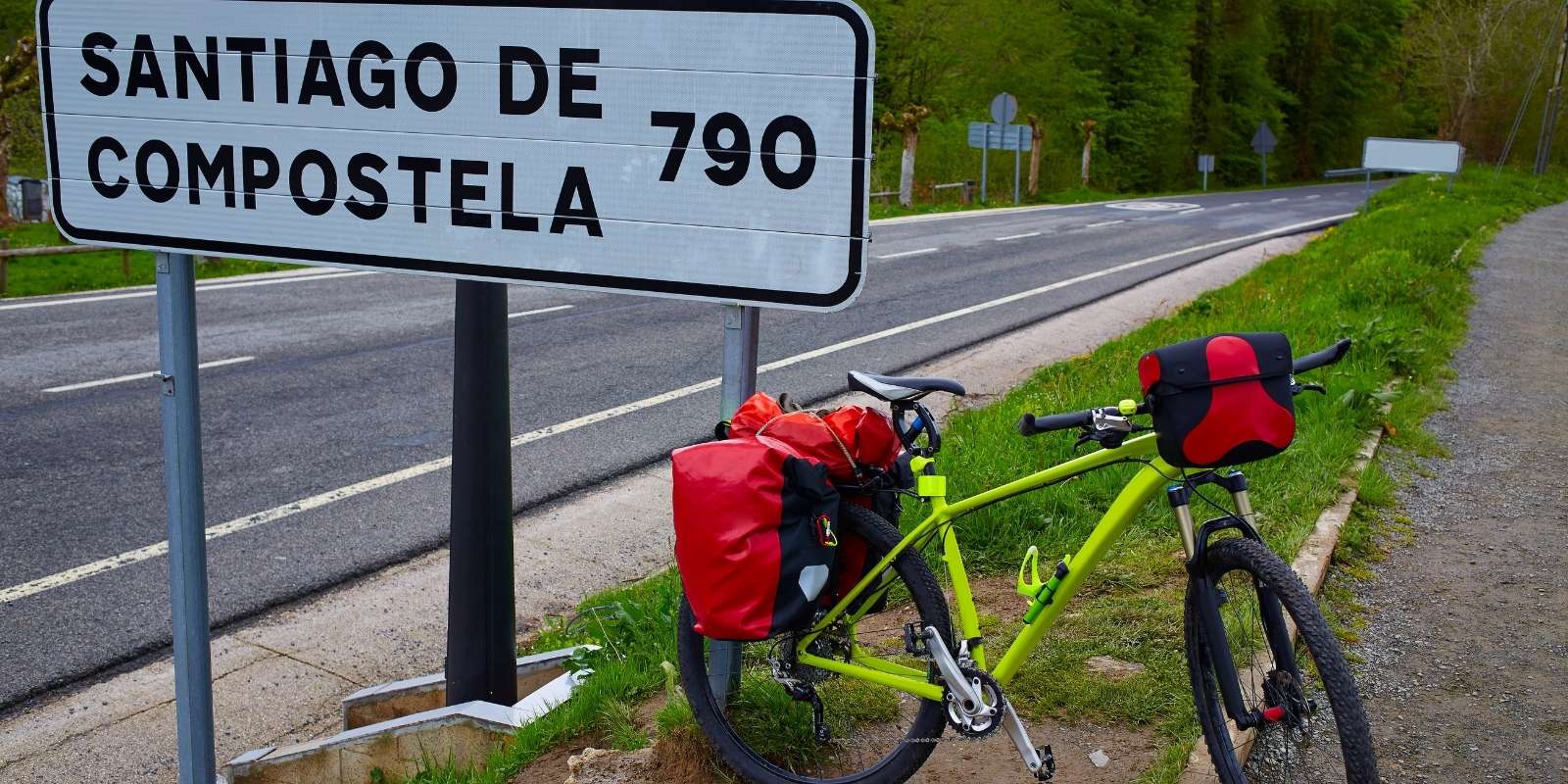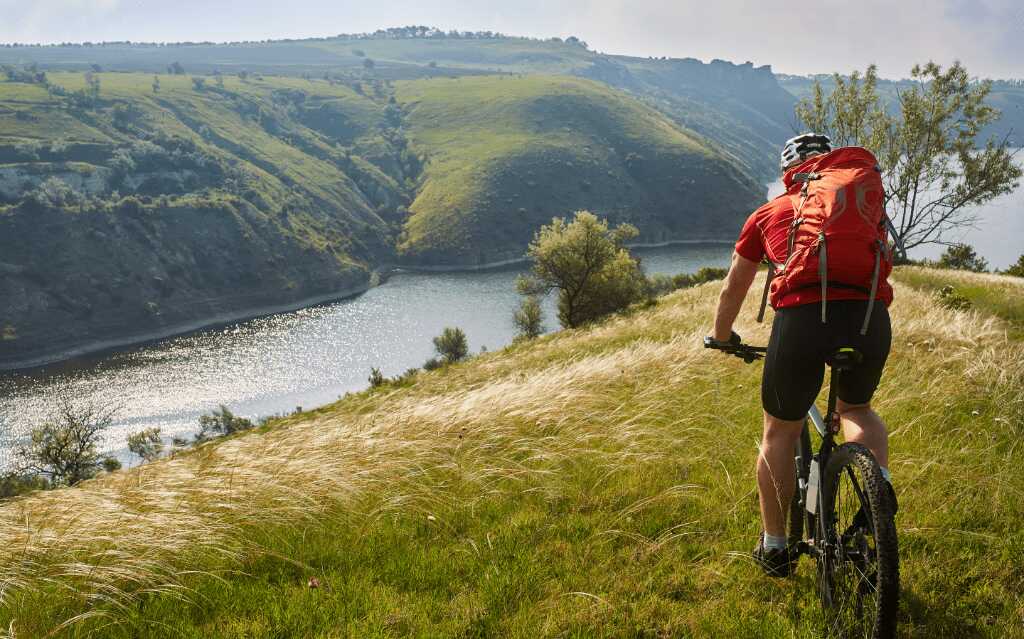Traveling light is the key to enjoying every pedal stroke on the Camino de Santiago. No matter which Jacobean route you take, well-planned luggage will let you savor every climb and descent without distractions or extra weight. In this guide on what to pack for the Camino de Santiago by bike, you’ll find everything you need, organized by category and with insights into why each item is worth including — or skipping. This way, you’ll pack your panniers with confidence, without forgetting the essentials and, most importantly, without carrying unnecessary weight.

It’s recommended to be used to cycling and do some training before starting your Camino by bike
Your bike and getting it ready
Your bike is your means of transport and your adventure companion: spending some time tuning it up will prevent breakdowns and headaches along the way.
-
- Type of bike: gravel, MTB, or trekking with hybrid tires.
- Clean and lubricated transmission for smooth shifting.
- Checked brakes and pads at 70% or more.
- Puncture-resistant tires inflated to recommended pressure.
If you want to know more — maybe you don’t have a bike yet and are thinking of buying one — check out our complete bike selection guide. And remember, on our trips we can provide you with a rental bike to enjoy your Camino on two wheels, even if you’d prefer to do the Camino on an e-bike.

Make sure your bike is in good condition before setting off on the Camino
Cycling clothing and footwear
The first layer of your adventure is what goes on your skin: breathable clothing that regulates sweat, protects you from the ever-changing Jacobean winds, and dries quickly at the end of each stage. Equally important is your footwear: shoes that transfer energy to the pedal while staying comfortable when you need to walk. With a light, easy-to-wash, and versatile outfit for various climates, you’ll avoid chafing, blisters, and excess baggage.
Technical clothing
The right clothing regulates temperature, prevents chafing, and keeps you dry in changing conditions.
- 2–3 breathable shirts (short or long sleeves depending on the season).
- 2 padded cycling shorts; wash them daily if possible.
- Lightweight, packable windbreaker jacket.
- Waterproof pants and overshoes for heavy rain.
- Light leggings for cold or rainy days.

Wearing the right clothes will make your Camino more comfortable
Footwear
Good footwear improves pedaling and protects your feet during walks or sightseeing.
- Cycling shoes with cleats and walkable soles.
- Lightweight shoes for relaxing in the afternoon.
- Sandals or flip-flops for showering and letting your feet breathe.
Accessories that make a difference
These accessories enhance your safety and comfort. Many are mandatory by law or common sense; others help you stay organized, visible, and ready for the unexpected.
- Certified helmet (mandatory in Spain).
- Summer or winter gloves to prevent chafing.
- UV-filter sunglasses for protection against dust and insects.
- Neck gaiter or scarf to protect your neck and face on descents.
- Light cap for walking breaks.
- Waterproof rear panniers (15–20 L each).
- Hydration backpack or 750 ml water bottles.
- Rechargeable front and rear lights.
- Medium or high-security lock.
- Multitool kit + 2 inner tubes, patches, and pump.
- Bungee cords to hold a mat or extra jacket.

Make sure the gear you use suits you well
The route and season: dress accordingly
The route you choose and the season you do it in will determine the clothing you need. It’s not the same to cycle across the Castilian Plateau in August as it is in October along the Cantabrian coast, or to take on winter stages in mountainous areas. Adapt your clothing to the expected weather for each route and season to avoid unnecessary heat or cold.
- Summer: On inland or southern routes (like the Vía de la Plata or the Plateau of the Camino Francés), heat will be your main challenge. Choose very breathable, lightweight clothing: short-sleeved shirts, shorts, a cap, sunglasses, and sunscreen. You can skip heavy warm clothing but bring a light waterproof windbreaker for possible summer storms. If you’re cycling northern routes like the Camino del Norte, expect more rain and fog even in summer, so a rain jacket is still essential.
- Winter: In the colder months, you’ll need much warmer clothing. Add thermal layers to your luggage: thermal base layer, long leggings, fleece or insulated jacket, thick gloves, and neck gaiter. In mountain stages (e.g., crossing the Pyrenees on the Camino Francés or the Camino Primitivo), you might encounter snow or ice — pack waterproof overshoes and a solid rain jacket. Also keep in mind that days are shorter in winter: front and rear lights will help you stay visible when pedaling in the evening.
- Spring and autumn: These seasons are more unpredictable. Mix clothes of different thicknesses to layer up or down as temperatures fluctuate throughout the day. Spring usually brings cool mornings and warm midday sun; autumn often has mild afternoons and cold nights. Also, in much of Spain (especially in the north), rain is common in both spring and autumn — always keep a waterproof windbreaker within reach. With a layering strategy and rain planning, you’ll be ready for sudden weather changes.

All Jacobean routes are bikeable
Ride without the load: we’ll handle it for you!
Want to focus solely on enjoying yourself? Check out our organized Camino by bike trips and let us carry the weight: contact us, and we’ll offer you a comfortable and safe “bicigrino” journey. We’re here to help with whatever you need!












Leave A Comment